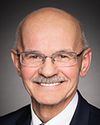Thank you. I could certainly start on that.
One thing they're finding is that by having high-quality forages...corn silage, for example, is a feed that helps to reduce it—and also just by increasing the production. Our quotas are based on butter fat, for example, so we feed the cows in such a way that we can get the right balance between butter fat and protein so that it takes less milk to fill our quotas.
There are some really interesting things that are happening out there. It's really more in the developmental stages, but there are certain kinds of seaweed, for example, that are known to considerably reduce methane emissions in cattle. I think there are opportunities. Obviously, we don't all live by the sea, so we don't have access to it, but certainly we feed additives, right? So we'll feed things.... We have the basic diets, but what really boosts our production are things like wheat distillers, grain distillers, canola meal and all of these good things that create more efficiency.
Also, through research, I think it's really important to continue to look for those various kinds of plants and feed additives that would help us to further reduce our methane emissions. In a sense, we've begun that, and I think there's a lot more potential out there.




